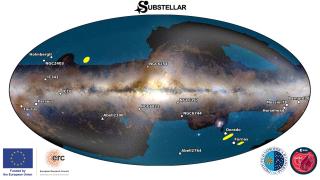Subvenciones relacionadas:
General
Nuestro proyecto puede dividirse en dos líneas principales de investigación. En primer lugar, el estudio de los vientos producidos por cuásares luminosos oscurecidos y del impacto que estos tienen en sus galaxias anfitrionas (retroalimentación del AGN). Para ello hemos obtenido observaciones en el óptico e infrarrojo cercano con el Gran Telescopio CANARIAS (GTC), en el infrarrojo medio con JWST, con ALMA en el rango milimétrico y con VLA en frecuencias de radio. Nuestro grupo está fuertemente involucrado en el consorcio internacional GATOS (Galactic Activity, Torus and Outflow Survey), creado con el objetivo de conseguir tiempo en el JWST y ALMA para caracterizar el ciclo del gas y el material que oscurece el núcleo de galaxias activas cercanas. En segundo lugar, nuestra actividad se centra en la aplicación de la espectroscopia de campo integral al estudio de objetos extensos tales como galaxias con formación estelar o galaxias activas para investigar el encendido de ambos fenómenos. Asimismo, contribuimos al desarrollo de nuevos instrumentos y técnicas de análisis de datos relacionadas con la espectroscopia 3D. En particular, participamos en el desarrollo del espectrógrafo de campo integral de alta resolución HARMONI, uno de los instrumentos de primera luz del Extremely Large Telescope de la ESO.
Miembros
Resultados
- La financiación externa conseguida desde 2020 por C. Ramos Almeida y B. García Lorenzo en el marco de este proyecto asciende a 2.370.500 euros. En 2024 se ha conseguido traer un nuevo contrato Juan de La Cierva al grupo, que disfrutará Marina Bianchin.
- Se ha continuado publicando trabajos basados en datos del proyecto QSOFEED, cuyo objetivo es cuantificar el
impacto de la retroalimentación del AGN en las galaxias anfitrionas (Bessiere et al. 2024; Holden et al. 2024; Speranza et al. 2024). - Giovanna Speranza defendió su tesis doctoral, titulada "Incidence and energetics of AGN winds in the local Universe" en febrero de 2024 en la modalidad de compendio de publicaciones (Speranza et al. 2021, 2022, 2024). En el marco del programa BID4BESt se han publicado otros siete artículos liderados por doctorandos de la red en los que participa C. Ramos Almeida.
- En el marco del proyecto QSOFEED se consiguió tiempo con ALMA en el ciclo 11 y con VLT (PI: A. Audibert), y se han observado los datos de JWST del ciclo 2 (PI: C. Ramos Almeida). También se ha conseguido tiempo con JWST como parte del consorcio GATOS en el ciclo 3 (propuestas 4972 y 5017).
- Como parte de la colaboración GATOS, se han publicado diez trabajos en los que han participado entre uno y cuatro miembros de este proyecto.
- Se ha establecido una nueva colaboración con ESO para explorar la aplicabilidad de la técnica desarrollada en el
marco de este proyecto para la estimación de la escala externa de la turbulencia en observaciones IFS corregidas con óptica adaptativa, con la adquisición de datos MUSE-AO para su análisis en 2025.









